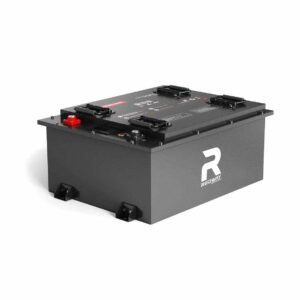What Are the Best 6-Volt Deep Cycle RV Batteries and How Do They Work?
What are 6-volt deep cycle RV batteries? These batteries are designed to provide steady power over extended periods, ideal for RVs. Unlike starter batteries, they withstand repeated discharging/recharging. Two 6V batteries wired in series create a 12V system, doubling capacity while maintaining voltage. Popular brands include Trojan, Crown, and Lifeline, known for durability and deep discharge recovery.
How Do 6-Volt Deep Cycle Batteries Differ from 12-Volt RV Batteries?
6V batteries have thicker lead plates, enabling deeper discharges (50-80%) without damage. When paired in series, two 6V units offer higher amp-hour capacity than a single 12V battery. For example, two 6V 225Ah batteries create a 12V 225Ah system, while a standalone 12V battery typically provides 100-150Ah. This setup extends runtime for appliances like refrigerators and inverters.

Another critical distinction lies in energy density and weight distribution. A pair of 6V batteries often weigh 10-15% more than a comparable 12V unit due to reinforced internal structures, which contributes to their ability to handle deeper discharge cycles. This makes them particularly effective for RVs with high power demands, such as those using solar panels or inverters for extended off-grid stays. The series configuration also reduces voltage drop over long wiring runs compared to parallel 12V setups.
Which 6-Volt Deep Cycle Batteries Are Most Durable for Boondocking?
Flooded lead-acid (FLA) batteries like Trojan T-105 dominate for budget-conscious users, offering 5-8 years with proper maintenance. AGM variants (e.g., Lifeline GPL-6CT) suit vibration-prone RVs, needing no watering. Lithium-ion options (Battle Born 6V) provide 3,000+ cycles but cost 3x more. Trojan’s Industrial Grade series withstands 1,200 cycles at 50% depth of discharge, ideal for off-grid use.
| Battery Type | Cycle Life | Maintenance | Cost per Ah |
|---|---|---|---|
| Flooded Lead-Acid | 500-800 cycles | Monthly watering | $0.15 |
| AGM | 800-1,200 cycles | None | $0.35 |
| Lithium | 3,000+ cycles | None | $0.85 |
For extreme environments, AGM batteries demonstrate superior performance in temperature fluctuations. Their sealed design prevents acid spills during off-road travel, while lithium batteries maintain 95% capacity at sub-freezing temperatures with built-in battery management systems. Budget-focused boondockers should prioritize Trojan T-105s, while full-time RVers benefit from Lifeline’s 10-year AGM warranty.
How Should You Maintain 6V RV Batteries in Extreme Temperatures?
In heat above 90°F, check water levels monthly—distilled water only. Use thermal wraps to prevent electrolyte evaporation. Below freezing, keep batteries at 75%+ charge; discharge below 50% risks sulfation. Temperature-compensated chargers adjust voltage (14.7V at 32°F vs 13.8V at 80°F). Trojan recommends equalizing FLA batteries every 30 cycles in hot climates to prevent stratification.
High temperatures accelerate chemical reactions, increasing water consumption by 40% in flooded batteries. Install reflective battery box covers to reduce internal temperatures by 10-15°F. In cold climates, use insulation blankets rated for -20°F operation. Lithium batteries require minimal maintenance but need preheating below 14°F for charging. Always store batteries at 100% charge in freezing conditions and use a desulfator if voltage drops below 12.4V for extended periods.
“Modern 6V AGMs can deliver 800+ cycles at 70% depth of discharge—double their flooded counterparts. The key is avoiding partial state-of-charge (PSOC) scenarios. For solar setups, I recommend 3-stage chargers with absorption phases lasting 4-6 hours. Lithium’s upfront cost drops when you factor in zero maintenance and 10-year lifespans.” – RV Power Solutions Engineer
What Wiring Configurations Maximize 6V Battery Bank Efficiency?
Series wiring (6V + 6V = 12V) is standard. For larger banks, create 12V blocks first, then parallel-connect them. Example: Six 6V batteries form three 12V pairs. Use 2/0 AWG cables for banks over 400Ah to minimize voltage drop. Install busbars for clean connections and fuse each 12V block at 125% of max amp draw. Always balance charge individual batteries before linking.
Conclusion
6V deep cycle batteries offer RVs extended power reliability through robust construction and flexible configurations. While requiring careful maintenance, their longevity and performance in deep discharge scenarios make them ideal for off-grid adventures. Emerging lithium technologies promise lighter alternatives, but traditional lead-acid remains cost-effective for moderate users.
FAQs
- Can I mix old and new 6V batteries in my RV?
- No—mismatched batteries cause uneven charging. Voltage variance over 0.2V between cells accelerates degradation. Replace all batteries in a bank simultaneously.
- How often should I test my 6V battery’s specific gravity?
- Monthly for flooded batteries. Optimal readings: 1.277 ±0.007 when fully charged. Differences over 0.05 between cells indicate sulfation.
- Do lithium 6V batteries require special inverters?
- Yes—use inverters with adjustable absorption voltages (14.2-14.6V for lithium vs 14.8V for FLA). Over-voltage protection should trigger below 15V.
